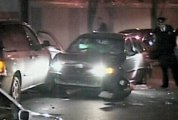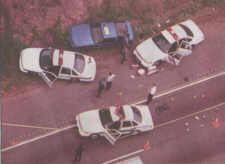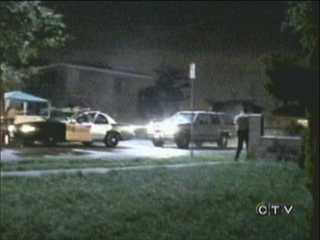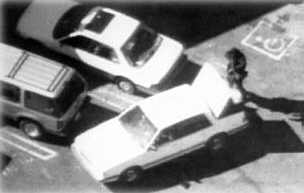|
By
Thomas J.
Aveni, MSFP
The Police Policy
Studies Council
December 2006
 On the weekend of November 25-26th, after a dramatic NYPD shooting
incident, local and national media sources screamed inflammatory
headlines, such as; “Fiancée of Slain Groom Calls Police 'Murderers'”[i]
and “Unarmed Groom Killed By NYPD Bullets.”[ii]
And, so we were told of how seven NYPD officers,
members of an undercover team that was investigating drug and
prostitution activity at a seedy bar, committed an unspeakable atrocity
against three young men who were (by omission of salient background
information) characterized as innocent victims of “trigger-happy”
police. But, in your heart-of-hearts, you know the other side of the
story wasn’t being told. On the weekend of November 25-26th, after a dramatic NYPD shooting
incident, local and national media sources screamed inflammatory
headlines, such as; “Fiancée of Slain Groom Calls Police 'Murderers'”[i]
and “Unarmed Groom Killed By NYPD Bullets.”[ii]
And, so we were told of how seven NYPD officers,
members of an undercover team that was investigating drug and
prostitution activity at a seedy bar, committed an unspeakable atrocity
against three young men who were (by omission of salient background
information) characterized as innocent victims of “trigger-happy”
police. But, in your heart-of-hearts, you know the other side of the
story wasn’t being told.
Certainly,
provocative actions by the three “unarmed” suspects initiated the tragic
series of events that transpired that morning. People who frequent
disreputable night clubs, have extensive criminal records, solicit
prostitutes, announce (within earshot of police), “Yo, get my gun!” and
then use their vehicle as a battering ram against undercover police
vehicles, are seldom innocent victims of the dangerous circumstances
that they’ve created. But this article isn’t about placing blame for
what transpired that day. It’s about setting the record straight about
officer-involved shootings that involve numerous officers in incidents
that have been erroneously termed “contagious fire” episodes.
What do we know
about incidents in which multiple officers are involved in a gunfight?
Unfortunately, what we know is dwarfed by what we don’t know. And that
is precisely the reason why so many “experts,” with few facts, have been
allowed to offer what are at times outlandish hypotheses about why these
incidents often result in tragic consequences. Even the terminology
bandied about is problematic, and contributes to even greater
misunderstanding. Having admitted this, it would be best to begin
establishing acceptable terminology with which to begin examining at
this phenomenon in more detail.
“Bunch Shootings”
The
genesis of the term “bunch shooting,” as it applies to multiple officer
shootings, is unclear. The first time that the author can remember
seeing this term used was in a 1992 article
[iii]
that appeared in the Oregonian newspaper – an
article that made some oblique references to the fact that officers that
fired in “bunches” tended to fire a higher ratio of rounds per officer,
per incident. Since the article loosely examined incidents involving an
agency that had been transitioning from revolvers to pistols, and which
had suspended handgun training for nearly two years due to manpower
constraints, it was difficult to discern whether the Portland Police
statistics offered a reliable insight into the “bunch shooting”
phenomenon.
The Contagious Misnomer
When looking for the
wellspring of the term “contagious fire,” we are drawn to the field of
clinical psychology. There we find the likely genesis of the term in the
phrase “emotional contagion.” An ‘emotional contagion' is the tendency
to feel emotions that are similar to and influenced by those of others.
This sounds innocuous enough, right? Not really. This is often cited as
being analogous to yelling “fire” in a crowded theater, instigating a
stampede of undisciplined, panic-stricken people. Does this analogy best
represent the behavior of police when involved in a bunch shooting?
There is a paucity of evidence to support any such conclusion.
“Synchronous Fire"
The term,
“synchronous fire,” is gaining acceptance as a label for
multiple-officer shootings, and it deserves closer examination. The
generic definition of synchronous action is that which occurs or exists
at the same time, moving or operating at the same rate. In the real
world, synchronous fire generally isn’t what that generic definition
would imply. A bystander may hear what he thinks is a steady stream of
gunfire, but upon closer examination, we’ll find that some officers
fired while others did not, or that some fired their magazines empty
while others did not. However, there is another dimension to
synchronicity, and it’s one that may be worth embracing.
Swiss
Psychologist, Carl Jung, postulated
[iv]
that “synchronicity” was best described as,
"temporally coincident occurrences of acausal
events." Jung spoke of synchronicity as an "acausal connecting
principle" (i.e. a pattern of connection that cannot be explained by
direct causality). In Jung's mind, cause-and-effect seemed to have
nothing to do with it. Jung explained that synchronicity, while not a
matter of coincidence,
is the experience of two or more occurrences
that are logically meaningful (but inexplicable) to the persons
experiencing them.
Jung’s definition of a
synchronous event could logically explain the phenomenon of parallel
events or circumstances that we see in multiple-officer shootings;
interconnected in space and time, yet not cleanly connected in
causality.
“Mass Reflexive Response”
In 1999, four NYPD
“street crimes” unit officers found themselves involved in the tragic
mistake-of-fact (low light) shooting of Amadou Diallo. After mistaking
an object in Diallo’s hand for a gun, the four officers fired a total of
41 shots at Diallo, striking him 19 times. Thereafter, a new phrase
began creeping into the NYPD lexicon; “mass reflexive response.” The
definition that we’re given for “mass reflexive response” is;
"Gunfire that spreads among
officers who believe that they, or their colleagues, are facing a
threat. It spreads like germs, like laughter, or fear."
When examining
this definition, few would challenge the central part of this definition
regarding officer perception of events; “….who believe that they, or
their colleagues are facing a threat..” But, when bracketed between the
rest of the verbiage (“Gunfire that spreads…..like germs, like laughter,
or fear”) this definition becomes extremely problematic.
Additionally this
definition is also interchangeable enough to be used verbatim to define
“contagious fire,” and it often is. Before you allow this terminology to
seduce you, let’s examine the core issues that are routinely overlooked
by “experts” and the media.
Lowlight, Multiple-Officer
Confrontations
We all
recognize the fact that threat identification is extremely problematic
under low light conditions. So much so that up to 75%[v]
of all police “mistake-of-fact shootings” occur under low light
conditions. So what does this have to do with police bunch shootings?
The correlation between low light conditions and bunch shootings that
end in mistake-of-fact tragedies is quite compelling.
Daylight shootings, and even diminished light
shootings where facts are clearly established, tend to have far fewer
unarmed suspects shot mistakenly. And, when
confronting the question about whether we are more concerned about
whether the decision to shoot was appropriate or whether the number of
rounds fired was “excessive,” it’s quite clear that the root of
community outrage originates in why we shoot more than how many rounds
that we fire thereafter. A high volume of fire may throw gasoline on the
fire, but community outrage is almost always initiated by the perceived
lack of justification for using deadly force.
Case
studies of bunch shootings that have occurred under low light conditions
aren’t as ubiquitous as we’d like, but what we do have at our disposal
exhibits many common tendencies. There are many cases to cite, but two
compelling examples come immediately to mind.
 June 3, 1999, on
Interstate 80 in Parsippany-Troy Hills, New Jersey, Stanton Crew, was
shot and killed by four police officers from several jurisdictions.
Police had boxed in his car with their vehicles and he allegedly tried
to escape by maneuvering around them. His driver’s license was suspended
for lapsed insurance, and as he drove home, a cop tried to pull him over
for “driving erratically.” Reportedly afraid that he would not be able
to afford the fines for driving an uninsured car, Mr. Crew allegedly
sped up, going 70-80 mph for ten miles. He then crossed the median and
drove five miles in the other direction before being boxed in. Police
claim they feared that Mr. Crew was going to run them over. Cops fired
27 shots at his car, killing Mr. Crew and wounding his passenger. Though
reports stated that police feared Crew’s vehicle presented a threat to
their safety, after-action analysis suggested that the police units that
boxed-in Crew’s vehicle found themselves in a crossfire of their own
making (see photo), with police rounds striking other police vehicles.
This likely added to the confusion present as to the degree of threat
that Stanton Crew presented. Analysis: Vehicular pursuit, low light conditions,
suspect behavior that was perceived to be assaultive, and possible
confusion about the origin of gunfire striking police units, and we have
four officers firing 27 rounds at an “unarmed” individual. June 3, 1999, on
Interstate 80 in Parsippany-Troy Hills, New Jersey, Stanton Crew, was
shot and killed by four police officers from several jurisdictions.
Police had boxed in his car with their vehicles and he allegedly tried
to escape by maneuvering around them. His driver’s license was suspended
for lapsed insurance, and as he drove home, a cop tried to pull him over
for “driving erratically.” Reportedly afraid that he would not be able
to afford the fines for driving an uninsured car, Mr. Crew allegedly
sped up, going 70-80 mph for ten miles. He then crossed the median and
drove five miles in the other direction before being boxed in. Police
claim they feared that Mr. Crew was going to run them over. Cops fired
27 shots at his car, killing Mr. Crew and wounding his passenger. Though
reports stated that police feared Crew’s vehicle presented a threat to
their safety, after-action analysis suggested that the police units that
boxed-in Crew’s vehicle found themselves in a crossfire of their own
making (see photo), with police rounds striking other police vehicles.
This likely added to the confusion present as to the degree of threat
that Stanton Crew presented. Analysis: Vehicular pursuit, low light conditions,
suspect behavior that was perceived to be assaultive, and possible
confusion about the origin of gunfire striking police units, and we have
four officers firing 27 rounds at an “unarmed” individual.
February 20, 1998, on Route
195 in Swansea, Massachusetts, at about midnight, an incident occurred
in which four officers from two adjoining jurisdictions engaged Richard
Parker in a brief vehicular pursuit for what was initially a motor
vehicle violation. As Parker lost control of his vehicle at exit 185,
he exited his vehicle and had four officers engage him with a total of
50 rounds fired. Six of those 50 rounds strike Parker, but he survives
the incident. Officers, hampered by adverse light conditions where the
chase culminated, stated that they saw Parker’s hands come together as
he exited the vehicle. They also stated that they saw something
reflective in his hands. Post-incident analysis indicated that Parker’s
shiny leather gloves likely misled officers into believing that he had a
handgun, as did his physical posture as he exited his vehicle.
Analysis: Low light conditions,
along with compelling situational and behavioral cues exhibited by the
suspect, resulted in 50 rounds being fired by four officers at an
“unarmed” suspect in a few brief seconds.
Pandemonium, Not “Panic”
 Events of May 9,
2005 in Compton, California, were brought into the living rooms of
millions of Americans. Captured on video was the aftermath of a 12
minute vehicular chase in which 13 deputies from the Los Angeles County
Sheriff’s Department engaged an “unarmed” suspect with over 120 rounds
of handgun fire. The suspect, 44-year-old Winston Hayes, was hit only
four times and survived. Yet another example of a low light
multiple-officer shooting, there was apparent confusion (before any
rounds were fired) after one deputy fell near the suspect’s moving
vehicle. Again we have a low light shooting that likely sprung from
confusion and mistake of facts. However, as you watched the deputies
fire, with many standing upright without utilization of cover, panic was
not outwardly apparent. Was there a “mass reflex” of 13 deputies to fire
simultaneous volleys? Or, in the confusion of the night, did 13 deputies
make 13 individual errors in judgment? Can one officer’s error influence
the decision-making of other officers? Absolutely, it happens all of the
time. But, this is a far cry from being anything we might liken to an
“emotional contagion.” Events of May 9,
2005 in Compton, California, were brought into the living rooms of
millions of Americans. Captured on video was the aftermath of a 12
minute vehicular chase in which 13 deputies from the Los Angeles County
Sheriff’s Department engaged an “unarmed” suspect with over 120 rounds
of handgun fire. The suspect, 44-year-old Winston Hayes, was hit only
four times and survived. Yet another example of a low light
multiple-officer shooting, there was apparent confusion (before any
rounds were fired) after one deputy fell near the suspect’s moving
vehicle. Again we have a low light shooting that likely sprung from
confusion and mistake of facts. However, as you watched the deputies
fire, with many standing upright without utilization of cover, panic was
not outwardly apparent. Was there a “mass reflex” of 13 deputies to fire
simultaneous volleys? Or, in the confusion of the night, did 13 deputies
make 13 individual errors in judgment? Can one officer’s error influence
the decision-making of other officers? Absolutely, it happens all of the
time. But, this is a far cry from being anything we might liken to an
“emotional contagion.”
Influence of Adversary’s Weapon
 Does the capability of an
adversary’s weapon have a discernable influence on the volume and
efficacy of police gunfire? Absolutely. Observational research of Los
Angeles County shootings (1998-2002) suggested that bunch shootings were
three times more likely to involve suspects armed with shoulder weapons
(i.e., rifles and shotguns). How critical is that as an incident
variable? (see comparison table below) Anyone watching dramatic video of
the 1997 “North Hollywood Shoot-Out” noticed how much distance officers
maintained from the two heavily armed and armored suspects (Phillips and
Matasareanu) who fired more than 1,100 rounds at many of the more than
350 officers who responded to that call. The suspects were armed with an
assortment of fully automatic and semi-automatic weapons that included
AK-47 variant rifles, an H&K 91 (.308) and AR15 (.223). Of the hundreds
of pistol and shotgun rounds fired by police, the suspects sustained a
total of only 40 hits[vi]
(Phillips was shot 11 times and Matasareanu was shot 29 times). The body
armor worn by the suspects defeated many of the 9mm and buckshot rounds
fired at them by police. Greater standoff distances (between police and
adversaries) diminish police hit ratios, which in turn tends to invite a
greater volume of police fire. Does the capability of an
adversary’s weapon have a discernable influence on the volume and
efficacy of police gunfire? Absolutely. Observational research of Los
Angeles County shootings (1998-2002) suggested that bunch shootings were
three times more likely to involve suspects armed with shoulder weapons
(i.e., rifles and shotguns). How critical is that as an incident
variable? (see comparison table below) Anyone watching dramatic video of
the 1997 “North Hollywood Shoot-Out” noticed how much distance officers
maintained from the two heavily armed and armored suspects (Phillips and
Matasareanu) who fired more than 1,100 rounds at many of the more than
350 officers who responded to that call. The suspects were armed with an
assortment of fully automatic and semi-automatic weapons that included
AK-47 variant rifles, an H&K 91 (.308) and AR15 (.223). Of the hundreds
of pistol and shotgun rounds fired by police, the suspects sustained a
total of only 40 hits[vi]
(Phillips was shot 11 times and Matasareanu was shot 29 times). The body
armor worn by the suspects defeated many of the 9mm and buckshot rounds
fired at them by police. Greater standoff distances (between police and
adversaries) diminish police hit ratios, which in turn tends to invite a
greater volume of police fire.
Much was learned
from the North Hollywood shootout about police preparedness for similar
situations. But, overlooked was the fact that many officers were able to
respond with discipline through their own fears. Emotional contagion?
Where? Outwardly, it appears as if each officer experienced his/her own
version of hell, more than likely oblivious to everyone else’s personal
vision of hell. Mass reflexive response? Generally speaking, officers
hunkered down behind cars and concrete walls and fired only when an
opportunity presented itself.
|
AGGREGATE
SYNOPSIS
LOS ANGELES
COUNTY OFFICER-INVOLVED SHOOTINGS† 1998-2002* |
|
Shots Fired Per Officer With Only 1 Officer
Involved |
3.59 |
|
Shots Fired Per Officer With 2 Officers
Involved |
4.98 |
|
Shots Fired Per Officer With More Than 2
Officers Involved |
6.48 |
|
Hit Ratio In OIS With 1 Only Officer Involved
|
51% |
|
Hit Ratio In OIS With 2 Officers Involved
|
23% |
|
Hit Ratio In OIS With More Than 2 Officers
Involved |
9% |
|
* At the time this was originally published,
shooting data for 2002 was only available to September 23rd.
†
Data provided did NOT include data for
incidents where shots fired by officers had no suspect being
struck by fire.
|
Toward A More Global
Perspective
Much of the
emotional hysteria that we see exacerbated by the media tends to focus
on the fact that officers are now issued high-capacity handguns that
“encourage” high volumes of police fire. This transition has nudged the
number of shots fired per officer, per incident upward, but it has
absolutely no bearing on our decision to employ deadly force. In 1973,
when NYPD officers were all issued six-shot .38 Special revolvers, there
were 1.82 fatal police shootings per 1,000 officers; in 2005, there were
0.25 such shootings per 1,000 officers, bringing the absolute number of
police shootings down from 54 in 1973 to nine in 2005[vii].
The NYPD’s per capita rate of shootings is lower than many big city
departments.
With more than
37,000 uniformed officers, the NYPD is by far the country's largest
police force. Its police shootings often become fodder for the national
news outlets, yet NYPD seldom gets a fair shake in the media. At the
time this article was authored, December 9, 2006, NYPD has killed a
total of 11 suspects. To put NYPD shooting restraint in better
perspective, consider that so far this year, at least 19 people have
been killed by police in Philadelphia. Las Vegas, which has about 2,170
police officers, has had 12 people shot and killed by police so far this
year. In suburban Atlanta's DeKalb County, police have fatally shot 12
people so far this year. DeKalb County, with 700,000 residents, is
one-tenth the size of the New York City.
Clearly, so much
is lost in the emotion and noise generated by special interest groups in
the aftermath of a police shooting. If truth is truly the first victim
of war, perhaps the same can be said for the media “mugging” of truth in
the aftermath of a police shooting.
When examining multiple-officer shootings, we tend to see several
recurring variables that have profound training and policy implications.
However, we see so many dissimilarities in specific officer behaviors
that we should avoid succumbing to sweeping generalities. Characterizing
officer shooting behaviors as being “contagious” or “reflexive” should
be avoided until specific facts and circumstances have been exhaustively
evaluated.
[i]
http://www.cnn.com/2006/US/11/27/nyc.shooting.ap/index.html
[ii] http://www.cbsnews.com/stories/2006/11/26/national/main2208778.shtml
[iii] The Oregonian,
April 25, 1992, “Shootings: Who, What and How Many”
[iv] http://en.wikipedia.org/wiki/Synchronicity
[v] Aveni, Thomas.
“Following Standard Procedure.” Law & Order, Vol. 51, No. 8,
August 2003
[vi] http://en.wikipedia.org/wiki/North_Hollywood_shootout
[vii] http://www.city-journal.org/html/eon2006-12-04hm.html
|

